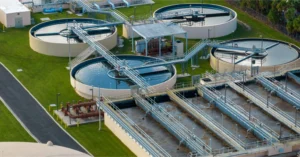Sewage Treatment Plant: MEP Construction Comprehensive Guide

In contemporary urban building infrastructure, MEP construction plays a central role in ensuring efficient, functional, and sustainable building systems. Among the most important components of MEP in engineering is design and installation of Sewage Treatment Plant in MEP Construction. STPs are critical to wastewater management and environmental sustainability.
This blog discusses the importance of MEP services in STP projects, emphasizing the importance of Mechanical, Electrical & Plumbing (MEP) systems and how MEP civil engineering works with these systems for optimal functioning.
What is a Sewage Treatment Plant?
A Sewage Treatment Plant is a facility designed to remove contaminants from wastewater and domestic sewage, converting it into safe water that can be released into the environment or reused. STPs help in reducing water pollution, protecting public health, and complying with environmental regulations.
In the context of MEP services, the design and execution of STPs involve a complex integration of mechanical, electrical, and plumbing systems.
Role of MEP in Sewage Treatment Plant
Mechanical Systems in STP
The mechanical part of MEP in engineering keeps all the moving parts of the sewage treatment plant in working order. This encompasses:
Wastewater transportation pumps and motors
Aerators for biological treatment systems
Agitators for effective mixing
Sludge handling machinery
Correct mechanical design is important to prevent failure, keep the flow levels constant, and improve equipment longevity.
Electrical Systems in STP
Electrical systems form the core of STPs. MEP construction involves the electrical configuration as follows:
Control panels for automated control
Sensors and instrumentation for measurement of water quality
Power supply systems for machinery such as pumps, blowers, etc.
Backup systems to avoid operational downtime
Efficient electrical design provides reliability, safety, and energy efficiency to the operations in sewage treatment.
Plumbing Systems in STP
Plumbing in MEP civil engineering is concerned with the correct flow and passage of wastewater from different stages of treatment. It comprises:
Inflow and outflow pipes
Flow control valves and fittings
Hookups to municipal sewerage lines and storm sewers
Hygienic drainage design to avoid leakages and contamination
Plumbing integration plays a crucial role to ensure cleanliness, avoid clogging, and make the treatment process more efficient.
Significance of MEP Construction in STPs
MEP installation is not merely a matter of installation—it’s integration. In sewage treatment plants:
Mechanical systems provide for proper treatment and flow.
Electrical systems provide for automation and operational safety.
Plumbing systems provide for wastewater routing and disposal.
As a team, MEP services guarantee that STPs are efficient, sustainable, and meet environmental standards.
MEP Civil Engineering in Sewage Treatment Projects
MEP civil engineering integrates structural design with mechanical, electrical, and plumbing systems. In an STP project, civil engineers do:
Design treatment process concrete tanks and chambers
Provide proper foundation and structural support for heavy equipment
Integrate MEP drawings with building structure and site limitations
This integration guarantees that the STP operates efficiently with considerations for safety and durability.
Advantages of a Properly Designed Sewage Treatment Plant
Having a well-integrated STP with robust MEP construction skills has multiple benefits:
Curbs environmental pollution
Conserves water through recycling and reuse
Decreases public health hazards
Guarantees environmental compliance
Adds value to residential and commercial developments
Conclusion
To summarize, MEP services are a must-have in the design and construction of sewage treatment plants. Combining Mechanical, Electrical & Plumbing systems with civil engineering expertise provides a seamless, efficient, and sustainable wastewater solution.
Through emphasizing MEP in engineering, developers, contractors, and municipalities can develop STPs that are not only useful but also eco-friendly


